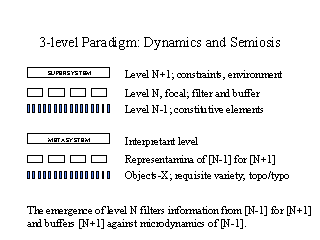
| Previous slide | Next slide | Back to first slide |
The basic logic of my argument is going to begin by creating a correspondence between material complexity and semiotic relationships in self-organizing systems, and then considering the semiotic connections between adjacent levels of material organization in such systems. We will find that very often these connections depend on an alternation between the typological and topological modes of semiosis, and will propose that this principle of alternation is both very general and helps us understand the nature of semiosis in even very simple material systems.
What kinds of systems enact semiotic processes? i.e. represent variety of one kind by variety of another for some interpreting (sub- or super-)system?
If we were concerned only with pure topological semiosis (i.e. quant-X by quant-R), perhaps we could argue that all material systems are semiotic; and if we include the role of the human observer, we could argue as well that all material systems as described by us participate in our chains and loops of sign processes.
But what is of interest here I think is to understand systems which make meaning, or use meaning, for themselves, even outside that portion of the epistemological loop that always includes us. I think we all suspect that such systems are the ones we call hierarchically organized complex systems: that only in systems with multiple emergent levels of organization is it truly possible to speak of systems of interpretance, of context-depedent meaning-for, rather than simple Shannon information.
The 3-level paradigm (best developed in the work of the biologist Stanley Salthe) for emergent levels in dynamical organization is also interpretable semiotically, and leads to a consistent semiotic model of the probable evolution of complex auto-semiotic systems. The figure above shows the re-interpretation of the material hierarchy of organized interactions in terms of semiotic relationships.
The basic 3-level paradigm for complex hierarchically organized systems maintains that whenever we seek to analyse a particular level of organization, the "focal" level, we need to take into account also at least (and in many kinds of systems at most) one level of organization "above" (the supersystem level, with longer characteristic times for slower processes, often occurring over much larger scales of spatial extension, and with greater total involved matter and energy) and one level "below" (the subsystems level, with shorter characteristic times for typically faster processes, often occurring over much smaller scales of spatial extension and with much less total matter and energy involved, per unit). The organization of the focal level depends on interactions among constituent units at the next lower level (whose properties matter to the focal level only through these interactions) and on contraints "from" the next higher level (which are in fact nothing more than boundary conditions on possible self-consistent, or self-sustaining patterns of collective interaction _at_ the focal level _of_ the units from the level below). The focal level acts to filter or buffer the causal influences between non-adjacent levels. The emergence of level N filters information from [N-1] for [N+1] and buffers [N+1] against the microdynamics (e.g. fluctuations) of [N-1].
The second part of the diagram above shows the correspondences for the semiotic relations. We will say that the focal level re-organizes typological (and/or topological) variety at the [N-1] subsystem level AS topological (and/or typological) meaning FOR the [N+1] supersystem level. This means that in effect some phenomena definable only at level N act as representamina (R) OF conditions at level [N-1] (i.e. the X's) FOR a system at level [N+1], which acts as the system of interpretance (SI) that 'reads' R's as 'signs of' X's and responds to these R's in ways that are functionally adaptive and appropriate for the conditions (X's) represented by these R's to the SI. (See examples to come.) Note that what is non-trivial in this account is that typological variety is re-organized across levels as topological meaning, and vice versa (i.e. the principle of alternation).